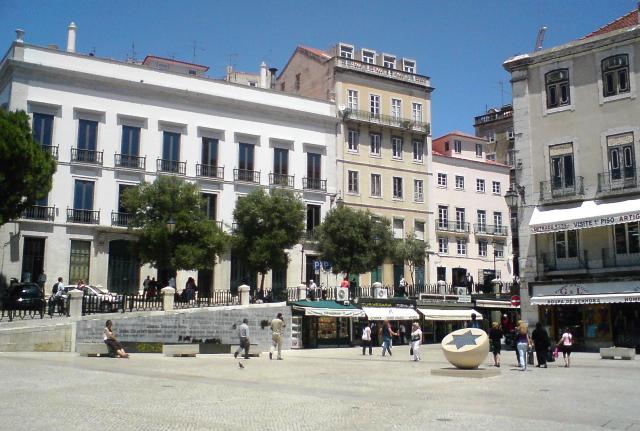Hundreds and Thousands
Lisboa - Rossio


From the guidelines: "People do not need to wait for permission to log your EarthCache. Requiring someone to wait is not supported by the EarthCache guidelines. People should send their logging task answers to you, then log your EarthCache. When you review their logging task answers, if there is a problem, you should contact them to resolve it. If there is no problem, then their log simply stands."
Hectic schedules and city life have made Man complacent about the use of mineral resources. Although much of the population is blissfully unaware of the importance of mineral resources, these play a fundamental role in our lives. Approximately 70% of the industrial production of the EU depends on this type of resources, e.g. paints and paper are composed of more than 50% of mineral resources such as kaolin, calcite, silica, plastic clays, talc, bentonite and mica. To place things in perspective a common house contains approximately 150 tons of mineral resources and a family car some 1500 kg.
Mineral resources have to be extracted from the earth by mining processes that are often viewed as harmful to the environment.
One such mineral resource that is quarried (mined) and put to frequent use in Portugal is limestone.
Limestone is a very common sedimentary rock of biochemical origin that is composed mainly of the mineral calcite. Limestones are seldom pure calcite and more often contain lots of other minerals and sand such that they are called “dirty limestones”.
The constituent calcite is derived mostly from bottom dwelling animals such as clams, brachiopods, bryozoa, crinoids and corals. When these animals die their shells accumulate into piles of shelly debris which can form the precursors of limestone beds. Limestones form usually close to the source of shelly debris (although some significant transport can occur). Because of limestone's biogenic origins, it is often a good rock for finding fossils.
 |
 |
In the western end of the Iberian Peninsula most limestones occur mainly from Lisbon to near Aveiro within what is geologically known as the Lusitanian Basin. This basin occupies approximately 200 km2 and is elongated in an NNW-SSE direction for 200 km and stretches perpendicularly to that for another 100 km. 2/3 of the basin are on the continental landmass and the remainder is submersed in the Atlantic. This sedimentary basin is made up of Cretaceous but mostly Jurassic age limestones that formed during the Mesozoic associated with the opening of the Atlantic Ocean.
The limestones outcropping in this basin make it the largest limestone production centre in the country with production hovering on 700000 tons/year and correspond to a net income of 50 million Euros mostly from foreign markets.
From within this basin the “Vidraço”, a type of beige, microcrystalline limestone is quarried and hand chiselled into small cubes measuring approximately 5x5x5 cm that are used in the characteristic paving stones (known as Calçada Portuguesa) set about throughout Portugal and the former colonies. What makes the Calçada special is the mixing of the beige Vidraço with a black Vidraço to make weird and wonderful patterns in the sidewalks.
 |
 |
Calçada was first used in its present day form in 1842 within the Lisbon area and this cache takes you to closely examine the limestones that make up the Calçada Portuguesa in an emblematic area: Rossio Square.
Therefore if you want to log another find in this EarthCache then you will have to observe some of the hundreds and thousands of limestone blocks and be able to answer the following questions:
The cache
1- How many rows of black limestone make up the western end of the outermost circle?
Options : 1, 2, 3, 4, 5, 6, 7, 8, 9
2- Of the beige limestone blocks within the circle do you see any that has larger calcite crystals in it?
Options : YES= Y; NO = N
3- What is the radius of the largest black circle?
Options (meters) : 1, 2, 3, 4, 5, 6, 7, 8, 9
4- Can you see any fossils within the circle?
Opções : YES = Y; NO = N
5- How is the roundness of the inner circles achieved?
Options : Square = S, Triangle = T, Rectangle = R, Diamond = D
6- How many of these features are there in the inner circle?
Option : 1, 2, 3, 4, 5, 6, 7, 8, 9
7- How many white stars are there in this pattern?
Options : 1, 2, 3, 4, 5, 6, 7, 8, 9
E-mail me the answer to pterogeo@gmail.com
The subject must be GC1T562-ANWSER , exemple GC1T562-1Y1YS11
(each letter from ANWSER corresponds in sequence to the question and their option)
 A cache
A cache 
1- Quantas linhas de calcário preto compõem o circulo exterior mais a oeste?
Opções : 1, 2, 3, 4, 5, 6, 7, 8, 9
2- Consegue ver nos blocos de calcário bege dentro do círculo alguns cristais grandes de calcite?
Opções : SIM = Y; NÃO = N
3- Qual é o raio do maior círculo preto?
Opções (em metros) : 1, 2, 3, 4, 5, 6, 7, 8, 9
4- Consegue ver alguns fósseis dentro do círculo?
Opções : SIM = Y; NÃO = N
5- Como é conseguido o arredondamento dos círculos mais internos?
Opções : Quadrado = S, Triângulo = T, Rectângulo = R, Losango = D
6- Quantas dessas ocorrências existem no interior do círculo maior?
Opções : 1, 2, 3, 4, 5, 6, 7, 8, 9
7- Quantas estrelas de cor branca existem neste padrão?
Opções : 1, 2, 3, 4, 5, 6, 7, 8, 9
Envie-me as respostas o e-mail pterogeo@gmail.com no seguinte formato:
O assunto do e-mail tem de ser GC1T562-RESPOSTA , exemplo GC1T562-1Y1YS11
(cada letra da RESPOSTA corresponde sequencialmente à pergunta e respectiva opção

A special thanks to DanielOliveira who have contributed to this EarthCache. You can visit his notable EarthCache work in:
http://www.geocaching.com/seek/nearest.aspx?tx=c66f5cf3-9523-4549-b8dd-759cd2f18db8&u=danieloliveira